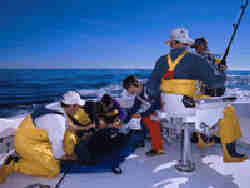Tagging the great white shark…and a few of his friends

Members of the Tuna Research and Conservation Center (TRCC) prepare to tag a tuna
What will some 4,000 of the smartest dressed elephant seals, tuna fish, albatrosses, leatherback sea turtles, great white sharks, and other pelagic megafauna in the Pacific all be wearing in the coming seasons? How about the latest in microprocessor-based electronic tags, some no bigger than oversized cufflinks? It’s all in a continuing effort to understand the habits of marine animals in that part of the world: what exactly lives where and why, what their migration routes and diving behaviors might be, and what might be going on in the ocean all around them – temperature, salinity and other physical data.
It’s called the TOPP program – Tagging of the Pacific Pelagics – and it is funded as one of the six pilot projects currently funded as part of the Census of Marine Life (COML). It will be a 10-year-long undertaking over a vast part of the world’s oceans, funded by the Office of Naval Research in partnership with the Sloan and Packard Foundations.
In recent years, technology that allows us to examine the migrations of large oceanic animals (pop-up satellite archival tags, satellite-linked data recorders, archival and sonic tags) has proven enormously successful. Animal movements and behaviors can be linked to oceanographic processes by integrating biological and physical data providing both atmospheric and oceanographic information, and offering unprecedented insights into the relationship between physical ocean processes and top predators like tunas, dolphins, and sharks. Fifteen to twenty species of pelagic organisms from several trophic levels, many with similar patterns of spatial and temporal distributions, will be monitored throughout the North Pacific. Simultaneous tagging of the target marine species will permit the monitoring of their movement and behavior relative to environmental conditions. Results from TOPP will provide a framework for future management and conservation of these economically and ecologically valuable resources.
“To be able to electronically tag and track many individuals of several different species across immense areas of the ocean is a daunting task,” says ONR marine mammal expert Robert Gisiner. “But, this program is going to allow us to study the movements of these animals both spatially and temporally at resolutions previously unknown.”
Media Contact
All latest news from the category: Earth Sciences
Earth Sciences (also referred to as Geosciences), which deals with basic issues surrounding our planet, plays a vital role in the area of energy and raw materials supply.
Earth Sciences comprises subjects such as geology, geography, geological informatics, paleontology, mineralogy, petrography, crystallography, geophysics, geodesy, glaciology, cartography, photogrammetry, meteorology and seismology, early-warning systems, earthquake research and polar research.
Newest articles

First-of-its-kind study uses remote sensing to monitor plastic debris in rivers and lakes
Remote sensing creates a cost-effective solution to monitoring plastic pollution. A first-of-its-kind study from researchers at the University of Minnesota Twin Cities shows how remote sensing can help monitor and…

Laser-based artificial neuron mimics nerve cell functions at lightning speed
With a processing speed a billion times faster than nature, chip-based laser neuron could help advance AI tasks such as pattern recognition and sequence prediction. Researchers have developed a laser-based…

Optimising the processing of plastic waste
Just one look in the yellow bin reveals a colourful jumble of different types of plastic. However, the purer and more uniform plastic waste is, the easier it is to…



